Beta-Glucan: Nature’s Key to Unleashing the Immune System
DISCLAIMER:This blog does not intend to provide diagnosis...
- In this article:
- What is Beta-Glucan?
- Not All Beta-Glucans Are The Same
- The Benefits of Beta-Glucan on the Immune System
- Clinical Studies on Yeast Beta-Glucan: Epicor and Wellmune
- Clinical Studies on Mushroom Beta Glucan
- Oat Beta-Glucan and Cholesterol
- Side Effects and Drug Interactions of Beta-Glucan

What is Beta-Glucan?
Beta-glucans are fiber-type polysaccharides (complex sugars) found in a variety of different food sources including yeast, oat bran, barley fiber, medicinal mushrooms (such as maitake and reishi), algae, and seaweeds.
Not All Beta-Glucans Are The Same
Some studies have shown that beta-glucan extracted from yeast has had the best overall benefit to immune health.
The beta-glucan of yeast, especially baker’s yeast (Saccharomyces cerevisiae) consists of a long beta-glucan core with branching side chains of other very specific lengths of other beta-glucans (beta-1,3-glucan and beta-1,6-glucan). Mushrooms like maitake also have beta-glucans with (beta-1,3-glucan and beta-1,6-glucan) side chains, but these side chains are much shorter than those of yeast. Beta-glucans in oats, barley, and rye have a linear chain of beta -1,3-glucan and beta-1,4-glucan.
These more simple forms of beta-glucans have shown great dietary fiber and cholesterol-lowering benefits, but do not have the same immune-enhancing effects as yeast and maitake beta-glucans.
The Benefits of Beta-Glucan on the Immune System
A major health benefit of beta-glucan, especially of the yeast and maitake mushroom varieties, is on the immune system. This has been extensively researched in the medical literature with literally thousands of preclinical studies detailing the unique benefits of beta-glucan. It turns out that our white blood cells actually have receptor sites on their cell surfaces for yeast and maitake beta-glucan. Just like a lock on a door is opened with only the right key, these receptor sites are specific to the structural makeup of the beta-glucan. When the yeast or maitake beta-glucan binds to the receptor it activates white blood cells in very specific ways to help fight off invading organisms. Here are the specific effects of yeast and maitake beta-glucan on the immune system:
- Increases levels of secretory Immunoglobulin A (IgA). This protective substance lines the mucus membranes of our body, e.g., the nasal passages, throat, airways, gastrointestinal tract, vagina, and urethra. Low levels of secretory IgA are associated with an increased risk of infection.
- Activates macrophages. These are specialized white blood cells that have taken up residence in specific tissues like the lining of mucus membranes, liver, spleen, and lymph nodes. Macrophages perform two vital functions. They act as garbage collectors to phagocytize or engulf foreign particles including bacteria and cellular debris. During that process macrophages analyze the threat to the immune system and, if necessary, send out chemical messages to other white blood to mount the response. So, in essence, yeast beta-glucan primes the entire immune system to function optimally.
- Activates monocytes. Monocytes are macrophages (garbage collectors) that circulate in the blood performing the same functions including being responsible for triggering many immune responses.
- Activates neutrophils. These cells also act as garbage collectors that actively engulf and destroy bacteria, tumor cells, and dead particulate matter. Neutrophils are especially important in preventing bacterial infection.
- Enhance natural killer (NK) cells. These cells are given the name because of their ability to destroy cells that have become cancerous or infected with viruses. The level of activity of natural killer cells in chronic fatigue syndrome, cancer, and chronic viral infections is usually low.
Clinical Studies on Yeast Beta-Glucan: Epicor and Wellmune
There are several different commercial forms of yeast beta-glucan. Clinical research exists on two special preparations produced from Baker’s yeast via proprietary processes more commonly known as Epicor and Wellmune. The dosages for both these forms of yeast beta-glucan is 500 mg daily, usually taken as 250 mg twice daily.
Epicor and Wellmune have proven to be effective in boosting immune function in humans in a total of over 20 clinical trials. Benefits noted are through the mechanisms discussed above on secretory IgA and the activation or enhancement of specific white blood cells and overall immune functions.
The clinical results from these studies with EpiCor and Wellmune show many effects useful in preventing upper respiratory tract infections (colds and the flu). EpiCor supplementation at a dosage of 500 mg daily had a beneficial effect on reducing the incidence of cold and flu symptoms in patients who either received or did not receive a flu shot. Wellmune at a dosage of 500 mg daily has also shown benefits in fighting off cold and flu symptoms in double-blind studies.
- No one participant in the Wellmune subject group missed a day of work or school due to cold symptoms. In contrast, subjects in the placebo group missed an overage of nearly 1.38 days during the trial.
- Additionally, while 3.5 participants in the placebo group had an incidence of fever, there were 0 fever incidences in the Wellmune group.
- Wellmune also had a great effect on improving quality of life, physical energy, and overall well-being.
Clinical Studies on Mushroom Beta Glucan
The research on maitake beta-glucan was pioneered by Dr. Hiroaki Nanba of Japan in the early 1980s, Dr. Nanba was researching the immune-enhancing properties of mushrooms when he came to the conclusion that maitake extracts demonstrated more pronounced activity in animal tests than other mushroom extracts. One of the key benefits to maitake was the ability to be quite effective when given orally. In contrast, the other mushrooms Dr. Nanba was studying such as shiitake were only effective when injected into the bloodstream.
In 1984, Dr. Nanba identified a fraction of maitake that possessed a significant ability to enhance macrophages. The fraction consisted primarily of beta-1,6 glucan and beta-1,3 glucan. While other mushrooms have been shown to have similar beta-glucan constituents, Dr. Nanba found that the beta-glucans found in maitake have a greater number of branching side chains. It is thought that the greater the degree of branching, the higher the likelihood the beta-glucan fraction will reach and activate a greater number of immune cells. The dosage of maitake extracts is based upon the level of the D- or MD-fraction containing beta-glucan, generally 35-70 mg of the D- or MD-fraction daily during acute need and 5 to 15 mg per day for daily support. For best results take 20 minutes before meals or on an empty stomach.
Oat Beta-Glucan and Cholesterol
While supplementation with yeast or mushroom beta-glucan has some benefits for its fiber-like effects on gastrointestinal function and contribution to the health of the intestinal microbiome – the collection of gut microbes so critical to overall health and immune function - the dosage is not sufficient enough to produce meaningful reductions in cholesterol levels. For this benefit of beta-glucan, it is best to use preparations of oat bran, barley fiber, or rye fiber-rich in beta-glucan. Of these three grains, it is oat beta-glucan that is widely available.
Whole oats, oat bran, and oat beta-glucan are all well-established as cholesterol-lowering agents. The beta glucan content of whole oats ranges from 3 to 5%, while the level in oat bran is usually between 15 and 35%. The cholesterol-lowering effect appears to be almost entirely due to the beta-glucan content as the consumption of at least 3g per day of oat beta-glucan can achieve a reduction in LDL cholesterol of up to 10%, thus reducing the risk of cardiovascular disease by as much as 20%.
Side Effects and Drug Interactions of Beta-Glucan
No side effects with beta-glucan sources are known at recommended levels.
References:
- Jin Y, Li P, Wang F. β-glucans as potential immunoadjuvants: A review on the adjuvanticity, structure-activity relationship and receptor recognition properties.Vaccine. 2018 Aug 23;36(35):5235-5244.
- Stier H, Ebbeskotte V, Gruenwald J. Immune-modulatory effects of dietary Yeast Beta-1,3/1,6-D-glucan. Nutr J. 2014 Apr 28;13:38.
- Samuelsen AB, Schrezenmeir J, Knutsen SH. Effects of orally administered yeast-derived beta-glucans: a review. Mol Nutr Food Res. 2014 Jan;58(1):183-93
- Moyad MA, Robinson LE, Zawada ET, et al. Immunogenic yeast-based fermentate for cold/flu-like symptoms in nonvaccinated individuals. J Altern Complement Med. 2010 Feb;16(2):213-8.
- Moyad MA, Robinson LE, Zawada ET Jr, et al. Effects of a modified yeast supplement on cold/flu symptoms. Urol Nurs. 2008 Feb;28(1):50-5.
- Feldman S, Schwartz H, Kalman D, et al. Randomized Phase II Clinical Trials of Wellmune WGP® for Immune Support During Cold and Flu Season. Journal of Applied Research. 2009;9:20-42.
- Fuller R, Moore MV, Lewith G, er al. Yeast-derived β-1,3/1,6 glucan, upper respiratory tract infection and innate immunity in older adults. Nutrition. 2017 Jul - Aug;39-40:30-35.
- Ulbricht C, Weissner W, Basch E, et al. Maitake mushroom (Grifola frondosa): systematic review by the natural standard research
- Ho HV, Sievenpiper JL, Zurbau A, et al. The effect of oat β-glucan on LDL-cholesterol, non-HDL-cholesterol, and apoB for CVD risk reduction: a systematic review and meta-analysis of randomized controlled trials. Br J Nutr. 2016 Oct;116(8):1369-1382.

 By Dr. Michael Murray, N.D.
By Dr. Michael Murray, N.D. 


